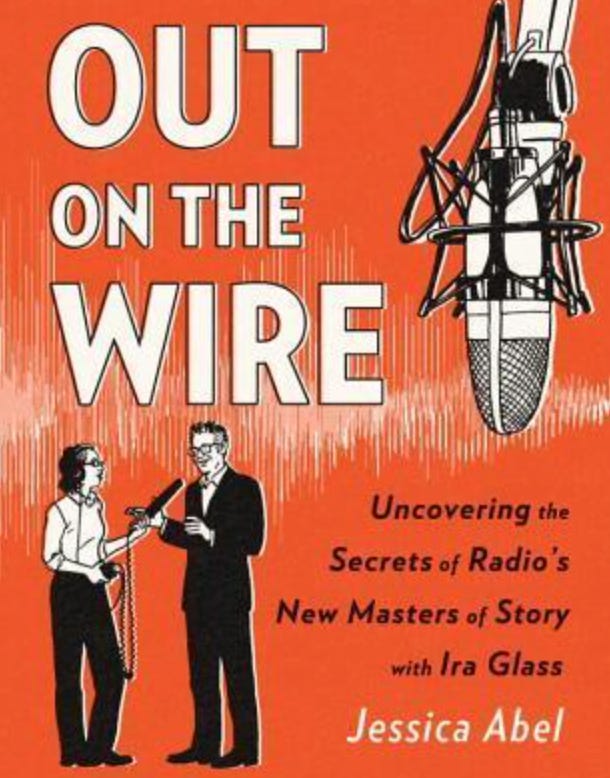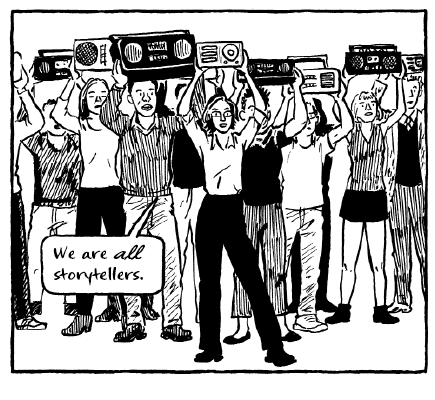20,000 Words Later
I'm not the only one confused about what to call this stuff, this thing...narrative audio
This month I made a promise to myself to sit and write at least 1,000 words every day, and attempt to keep focused on writing *just* about narrative audio, in honour of NaNoWriMo, but the non-fiction form.
I’ll be honest. When I sat down to plan this project in October (ok, truth, it was October 30…) I could only get to Day 5 on my FRED planning sheet (FRED stands for Formula For Reaching End Of Draft, a simple, great writing tool I found here).
I figured if I could get to Day 5, I would be doing just super. When that dried up, I could always more on to another topic to fill the rest of the month, or relax into some fiction writing.
Well, it turns out I have a lot to say about narrative audio podcasting
And, apparently, I know quite a bit about this teeny tiny little corner of the storytelling world. Yesterday was Day 15 and I hit 20,000 words; and, I’ve also outlined what to cover for the rest of the month each day, which puts me on target to hit the 50,000-word target.
Where this whole writing project goes to remains to be seen, but for now, it’s been a lovely way to start each day, extra early so I can still do everything else, with a giant cup of coffee in hand.
Any writer will tell you that part of the writing process is to read more about your topic
When you do a google search about narrative podcasting, there’s a short list that comes up. The top of any list will always have Out on the Wire: The Storytelling Secrets of the New Masters of Radio, by Jessica Abel and Ira Glass. I read this years ago, but this month I’ve gone back to read it again in detail.

If you haven’t come across Jessica’s work yet, I can’t suggest it highly enough. She’s a graphic novelist, creative coach, university professor, podcaster, and about a million other things at once. She’s almost too good to be true. Many years ago I took one of her early courses, her Creative Focus Workshop, and she’s helped to plot my course in many ways since then.
Out On The Wire was published in 2015, but her first project with Ira Glass was actually back in 1999, when she received a cold call, from Ira himself, asking her if she might be willing to come into the This American Life Offices and help create an illustrated “guide” about how to make the kind of “radio” they were pioneering at the TAL offices.
Imagine that scene: You’re a radio nerd and you get a random call from the person, whom you already feel like you know because you’ve spent hours listening to him , but you don’t actually know him, and he asks you to do a collab with him!
This experience led Jessica, more than a decade later, to circle back to this concept, but this time go out and meet with all of the other mavericks who were out there creating this new world of narrative audio storytelling.
So she spent time with basically all of the people who have helped build this industry from scratch: the OG team at This American Life (Nancy Updike, Julie Synder, Alix Spiegel and Jorge Just) and Radiolab (Jad Abumrod, Robert Krulwitch, Sean Cole and Soren Wheeler), Planet Money (Alex Blumberg, David Kestenbaum Chana Joffe-Walt), Snap Judgement (Glynn Washington and Julia DeWitt), Rob Rosenthal of the Transom Storytelling Workshop, The Moth (Jay Allison and Catherine Burns), Joe Richman at Radio Diaries, Roman Mars at 99% Invisible.
Continuing this list is getting embarrassing and definitely exposing me as super nerd among audio nerds. Here’s a tell: If you read these names and can then say where these people work now, you’re also in the super nerd camp. Welcome.
What Jessica and Ira created is, actually, a story within a textbook, of how to make a narrative podcast. But in the most creative, non-linear, illustrated format. Finding that tiniest button, how to describe the creative method people use, which is almost always from a gut feeling, is truly a work of brilliance.
As I settled back into this book, I was quickly struck by a conversation between Ira Glass and Jessica Abel about what this…thing…is that we all know and love.
Quoting the text feels flat. Please picture an illustrated image like this as you read on:
Jessica asks:
My search for more insight into storytelling has taken me full circle,
right back to narrative nonfiction audio stories.
… uh, public radio-based creative nonfiction narratives.
Wait, um … fact-based radio (and podcast) … no, audio storytelling
Ugh.
How do I still not know what to call this stuff???
The next frames are her asking Ira the same question.
Ira: Do you have a name for this kind of radio?
Ira answers:
No. No, no.
That would readlly help, wouldn’t it?
What is this kind of radio?
I mean, it’s story. We’re makin’ stories.
Ha, ha.
That’s what we call ‘em…
It’s narrative journalism, is what it is.
I mean … we don't…
I think you might be stuck with
“narrative journalism”
if you want to call it something.
I just want to make something that is compelling to me.
And I wish there was a not-pretentious way to
just say “compelling stories”
… you know what I mean?
After reading this book I suddenly felt less alone in the quest to land on a nomenclature for what you call narrative podcasting, without feeling like the words are cotton batton in your mouth. If if Ira is confused about it too, then I’m in good company.
But I also felt more decided that it is a good time to spend more time, spill more words into the universe, about this topic.
Hello 50,000 words. I’m coming for ‘ya.
On Friday (11/18) I’ll announce what we’re listening to next week on Bingeworthy…





